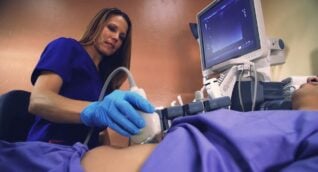Abdominal ultrasound is an imaging technique that uses sound waves to visualize structures inside the abdomen. This exam is typically used to evaluate problems with the kidneys, liver, gallbladder, bile ducts, pancreas, spleen, and abdominal aorta. A wide variety of problems can be detected with abdominal ultrasound, such as kidney stones, gallstones, cysts, abscesses, tumors, and aneurysms.
Abdominal ultrasound is a safe, non-invasive imaging method that does not expose you to ionizing radiation (X-rays). In many cases, abdominal ultrasound helps doctors make an accurate diagnosis without the need for more complex testing or exploratory surgery.
Doppler ultrasound is a specialized technique that can complement regular abdominal ultrasound. It allows for the measurement of blood flow speed and direction. Abdominal ultrasound can also be used to guide doctors when taking tissue biopsies using a method called ultrasound-guided biopsy.
More basic information on ultrasound is available in the About Ultrasound section.
Doctors use abdominal ultrasound to help determine the cause of symptoms coming from the abdomen. A patient may have stomach or back pain, or a mass might have been detected at a doctor’s visit. A variety of disorders can be diagnosed by abdominal ultrasound such as:
- Kidney stones
- Gallstones
- Tumors, abscesses, and cysts
- Aneurysms
- Blood clots
- Blood vessel narrowing
Benefits
- Abdominal ultrasound is an inexpensive, fast, and non-invasive way to assess structures inside the abdomen. In many cases, this test helps doctors accurately detect the cause of abdominal symptoms, avoiding more complex testing or exploratory surgery.
- Ultrasound does not expose you to any ionizing radiation (X-rays).
- Unlike MRI, ultrasound can be used in patients with any type of metal in their body, including implantable medical devices.
- Ultrasound is very safe and has no side effects.
- There is no need to take contrast for ultrasound exams.
- Ultrasound can detect soft tissue abnormalities that cannot be visualized with X-ray exams.
Risks
- The use of diagnostic ultrasound has no known risks or harmful effects.
- Abdominal ultrasound is done in an ARA outpatient imaging center. The exam will take about 30 minutes and you will be in the imaging center for about an hour.
- You may be asked to change into a gown.
- You will be placed lying on your back on an exam table. You may have to change position during the exam. For kidney ultrasound, you may be positioned face down or on your side.
- A water-based gel will be placed on the area to be examined. The gel creates a sealed contact between your skin and the ultrasound probe. This eliminates any air pockets that may interfere with imaging. The probe will be moved around to capture images from different locations. The gel does not stain clothing.
- The technologist or radiologist performing the study may have to apply pressure with the probe to the body part being examined. If the area is tender, you may experience some discomfort.
- The gel is wiped off of your skin.
- You can return to your normal activities after the exam is over.
- For exams of the liver, gallbladder, spleen, and pancreas you may be asked to avoid fat in your diet the evening before the test. Also, you may be asked to avoid eating and drinking for 8-12 hours before the exam.
- For kidney ultrasound, you may be asked to drink 4-6 glasses of liquid an hour before the exam. You may also be asked to avoid food for 8-12 hours before the test.
- For aortic ultrasound, you may be asked to avoid eating and drinking for 8-12 hours before the exam.
- Wear comfortable, loose-fitting clothing for the exam.
To schedule an abdominal ultrasound, please use our online scheduling tool in the Patient Portal or you may call our scheduling team at (512) 453-6100 or toll free at (800) 998-8214. A referral from your healthcare provider is required to make an appointment.
A radiologist, a physician specifically trained to interpret radiological examinations, will analyze the images and send a signed report to the provider who referred you to ARA. The physician will then share the results with you.

 Back to Top
Back to Top